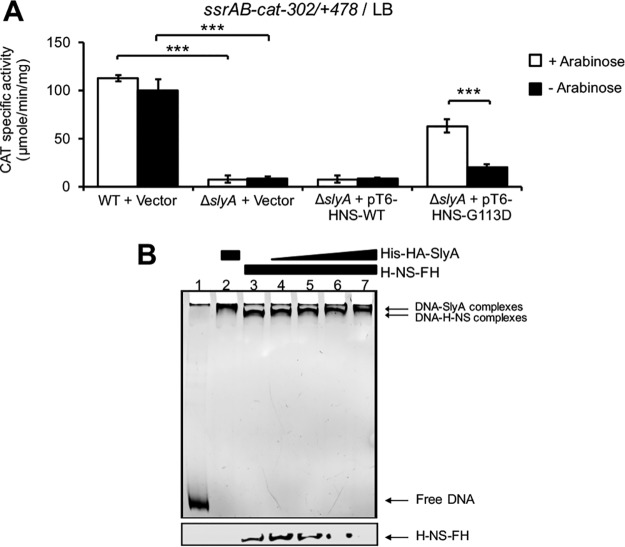FIG 2.
SlyA directly displaces H-NS-mediated repression on ssrAB during growth in LB. (A) Expression of the ssrAB-cat−302/+478 transcriptional fusion carried by the pssrAB-cat-302/+478 plasmid was tested in WT S. Typhimurium and its isogenic ΔslyA mutant containing or not containing the pMPM-T6Ω vector or the pT6-HNS-WT or pT6-HNS-G113D plasmid, which expresses WT H-NS or the dominant negative H-NSG113D mutant, respectively, from an arabinose-inducible promoter. CAT-specific activity was determined from samples of bacterial cultures grown for 9 h in LB at 37°C. l-Arabinose (0.1%) was added (+) or not added (−) to the medium for inducing the expression of WT H-NS and H-NSG113D from pT6-HNS-WT and pT6-HNS-G113D, respectively. Data represent the mean with standard deviation of the results from three independent experiments performed in duplicate. Statistically different values are indicated (***, P < 0.001). (B) Competitive nonradioactive EMSAs between H-NS and SlyA on the −302/+478 region of ssrAB. Purified H-NS−FH protein was added at 0.5 μM (lanes 3 to 7), and purified His-HA-SlyA protein was added at 1, 2, 2.5, and 3 μM (lanes 4 to 7, respectively). No proteins were added in lane 1, and His-HA-SlyA was added at 3 μM in lane 2. The DNA-protein complexes were resolved in a nondenaturing 6% polyacrylamide gel. Top, protein-DNA complexes stained with ethidium bromide; bottom, immunoblot detection of H-NS−FH from the DNA-protein complexes. Similar results were obtained from three different experiments.

